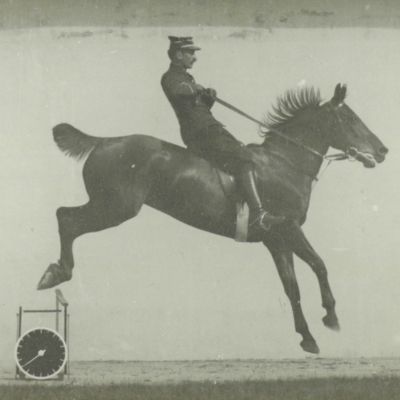Marey, É. J.
Physiologie des mouvement. Four original photographs of a jumping military horse.
France, É. J. Marey, 1895-1898. A series of four original albumen silver print plates (16.3 x 23.1; 16.4 x 23.0; 16.2 x 23.0; and 16.2 x 23.1 cm). Preserved in protective sleeves.
A fine set of four, consecutively shot, full-view photographs, with a timing clock visible, of ‘sauts du cheval’, showing a military horse jumping over a fence. An important contribution to the history of animal motion, bionics, physiology, and even cinematography because of the use of Marey’s self-invented ‘photographic gun’ (1882), which created images like those in the well-known works of Edward James Muggeridge, or ‘Eadweard Muybridge’ (1830-1904) as he preferred to be known, but actually preceding the latter’s work. And in contrast to Muybridge, the French medical doctor and inventor Étienne-Jules Marey (1830-1904, by sheer coincidence) was a scientist who knew the scientific importance of his photographs and methodologies. He was a member of the Académie nationale de Médecine and authored a well-illustrated, technical book on the flight of birds, Physiologie du mouvement. Le vol des oiseaux, based on photos made with the same technique. “He published La Machine animale in 1873 (translated as Animal Mechanism). The English photographer Eadweard Muybridge carried out his ‘Photographic Investigation’ in Palo Alto, California, to prove that Marey was right when he wrote that a galloping horse for a brief moment had all four hooves off the ground. Muybridge published his photos in 1879 and received some public attention. Marey hoped to merge anatomy and physiology. To better understand his chronophotographic images, he compared them with images of the anatomy, skeleton, joints, and muscles of the same species. Marey produced a series of drawings showing a horse trotting and galloping, first in the flesh and then as a skeleton. His work was significant in the development of cardiology, physical instrumentation, aviation, cinematography and the science of laboratory photography. Marey is widely considered to be a pioneer of photography and an influential pioneer of the history of cinema. He was also a pioneer in establishing a variety of graphical techniques for the display and interpretation of quantitative data from physiological measurement. ... He adopted and further developed animated photography into a separate field of chronophotography in the 1880s. His revolutionary idea was to record several phases of movement on one photographic surface.” (Wikipedia). This set of photos was taken between 1895 and 1898, and features a horse named Odette. Marey created a ‘movie’ by revolving the ‘photographic gun’ photos in a speed close to the actual speed of the horse. Very slight marginal creasing; the prints strong. An excellent set. DSB IX, pp. 101-103.




